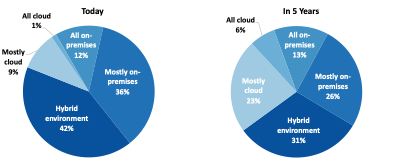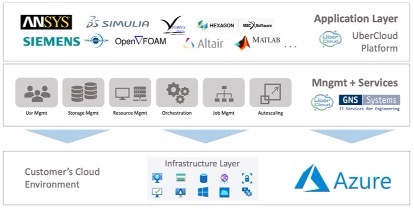Key takeaways:
- The creation of today’s highly complex cyber-physical products, combined with intense global competition and time to market pressures, requires significantly greater use of computer-aided engineering (CAE) to assess, validate, and optimize the functional performance of components and sub-systems, as well as complete systems.
- The expanded use of CAE, the cloud, big data analytics, digital twins, and AI/machine learning is driving the need for ever-increasing access to high performance computing (HPC) resources by significantly more engineers across the global enterprise.
- UberCloud provides enterprises of all sizes with an integrated, engineering computing environment for multi-discipline and multi-domain HPC applications running securely across public, private, or hybrid clouds.
- To provide customers with an easy to configure and highly efficient user experience, UberCloud integrates with major cloud and CAE software products.
Manufacturers in all industries have been applying digital modeling and simulation technologies since the 1970s but now face new challenges as products continue to become more complex, more functional, and more connected with an ever-increasing amount of embedded software and electronics as part of the Industry 4.0 “systems of systems” world. Industry leaders must leverage new and evolving technologies to digitalize their lifecycle development processes while maximizing and modernizing existing investments as well as competing with emerging start-ups that can digitally design new products faster and from scratch working in the Cloud.
The focus on incorporating simulation-driven design methods for the development of complex cyber-physical systems requires much higher fidelity, multi-disciplinary models (e.g. structural FEA, flow, thermal, combined CFD/thermal, acoustics, electromagnetics, optics, Multidisciplinary Analysis and Optimization (MDAO), design of experiments, etc.) to ensure the validity and accuracy of physics-based “digital twins.” These high-fidelity digital twins can then be used confidently to make critical design tradeoff decisions throughout the product lifecycle. Capabilities for multi-physics simulation, for cross-disciplinary data analytics, and for design optimization including the use of new artificial intelligence (AI) technologies to enable machine learning (ML) are driving the need for ever increasing amounts of high performance computing. The promised business benefits of the cloud and AI/ML have significantly raised the ROI expectations of senior management as well as making the use of these new technologies second nature for the next generation of engineers and technical scientists.
The use of HPC in the cloud (public, private, and hybrid) for product functional performance analysis and design optimization using CAE tools is expanding significantly due to these business realities and the economies of scale and global access provided by the cloud. These overall business trends on the use of the cloud are tracked by market analysts such as CIMdata in PLM market research focused on the engineering and product development markets as referenced in Figure 1, and by Hyperion Research.

Figure 1―Growth of CAE Cloud Environments Over Next 5 Years
(CIMdata Research on Future of Industry, 2021)
UberCloud: HPC Cloud as a Service
UberCloud is an independent cloud services company headquartered in Sunnyvale, CA, founded in 2012. UberCloud provides enterprises of all sizes with a flexible and scalable HPC cloud environment that runs multi-vendor CAE software applications securely on any Linux machines and in any cloud: public, private, or hybrid (see Figure 2). Companies can run UberCloud on their preferred public cloud provider, or in their own private cloud. With UberCloud’s HPC Cloud platform, engineers can easily scale the size and volume of simulations up and down as the product design and validation workloads require, while IT can control fixed infrastructure costs and manage network performance and security. The benefits of using UberCloud address the varying needs of senior management, IT, and engineering disciplines across the enterprise.
CIO and IT Organization
- Enterprise Integration―UberCloud’s HPC Cloud containers and its Kubernetes-based automated self-service engineering simulation platform can be fully integrated into the company’s IT environment as part of a company-wide digital transformation initiative.
- Control over Digital Assets―Implementation of the engineering simulation environment in a company’s own cloud account (unlike with many other cloud service providers) enables exclusive control over company CAE software licenses, simulation workflows, and data.
- No Price Markups―UberCloud allows customers to run their simulation environments within the customers’ own cloud subscription. Therefore, UberCloud customers enjoy all price-performance benefits offered by cloud providers without any price markups.
VP Engineering and CAE Managers
- Productivity―Increase in productivity of engineers, enabled by the fully automated self-service simulation platform. According to UberCloud, customers have seen on average a productivity increase factor of 10 in running simulations, with some reporting a factor of up to 40.
- Product Innovation and Quality―Engineers can rapidly evaluate many more design alternatives and discover design flaws and issues early in the design and development process and thus avoid product failures with costly product recall and repair processes.
- Flexibility―Access to the latest state-of-the-art hardware and CAE software technologies with a very good price-performance ratio, because the UberCloud simulation environment is running within the customer’s own cloud subscription.
CAE Analysts and Engineers
- Control―UberCloud’s automated cloud process allows engineers to configure a well-suited, application-adapted cloud resource environment and its interactive and batch use thus keeping the engineer “in the driver’s seat.”
- User-Friendly―“Cloud with one click” through browser-based, highly secure, interactive and batch use of the simulation environment, made possible by UberCloud’s standard “CAE containers” that codify the engineer’s complete simulation workflow, running in the engineer’s own “virtual cloud desktop” within the company’s cloud account.
- Ease of Use and Analyst Productivity―Same look and feel UI across all cloud services minimizes learning curve and enables rapid adoption by new users.
- Analysis Process Productivity―Avoids unnecessarily large data file transfers from cloud to on-premises CPUs by leveraging the integrated remote visualization of results with GPU-accelerated high-resolution images sent over the Internet.

Figure 2―UberCloud’s “Cloud-Neutral” Engineering Simulation Platform
(Courtesy of UberCloud)
UberCloud Industrial Application Examples
The UberCloud Engineering Simulation Platform has been successfully implemented on AWS, Azure, and Google Cloud since 2018 across a number of industries to enable multi-disciplinary design analysis and optimization. UberCloud focuses on the manufacturing, life sciences, energy, and finance industries and is used by some of the largest companies in the world. Some notable customer applications follow.
Buro Happold: Optimization of Building Designs using Explicit Nonlinear FEA
Headquartered in Bath, United Kingdom, this global firm has a history of building storied projects that push engineering boundaries―unforgettable edifices like the Sydney Opera House and Dubai’s Museum of the Future. The complex buildings combine aesthetics with precision engineering principles and high-performance standards to create buildings that, while beautiful, safe, and comfortable for humans, also ensure a sustainable future for the planet. Buro Happold needs massive computing power to support the engineering simulations that its engineers run to understand and deal with a range of interrelated performance factors as they optimize their designs for each site.
“With UberCloud and HPC on Azure, we’re breaking through the old barriers. We now run simulations in hours that used to take days. We push design boundaries further and further, and that’s exciting,” stated Mr. Gilberto Osornio Nieto, Senior CFD Engineer, Buro Happold.
For more details on Buro Happold’s use of UberCloud’s Engineering Simulation Platform, see https://customers.microsoft.com/en-us/story/1407081285387890777-buro-happold-professional-services-azurehttps://www.cimdata.com/en/resources/complimentary-reports-research/commentaries/item/20056-ubercloud-accelerating-innovation-using-high-performance-cloud-based-simulation-and-analytics-commentary
FLSmidth: Building Tomorrow’s Sustainable Infrastructure
FLSmidth is a Danish multinational company that focuses on sustainable engineering of infrastructure solutions, services, and equipment for the cement and mining industries. FLSmidth relies on globally dispersed teams serving clients around the world. As part of its digital transformation efforts to optimize its global HPC environments, FLSmidth adopted the UberCloud Engineering Simulation Platform, based on Microsoft Azure. UberCloud and Microsoft collaborated with a blended FLSmidth team, bringing the company’s engineering teams the performance and collaboration gains they need for continuing success.
“Azure CycleCloud and the Azure Kubernetes Service (AKS) are user-friendly ways of provisioning HPC resources. That’s why we combined them with our UberCloud Engineering Simulation Platform. It only takes a couple of quick steps for an engineer to set up and access a compute cluster. Within minutes, they have new resources available to them―and it dramatically reduces overhead on IT to provision resources,” according to Mr. Wolfgang Gentzsch, President UberCloud.
For more details on FLSmidth’s use of the UberCloud Engineering Simulation Platform, see https://customers.microsoft.com/en-us/story/1417831248134599964-flsmidth-manufacturing-azure
Freudenberg Technology and Innovation
Freudenberg Technology and Innovation (FTI) is an engineering facility providing expertise and simulation services to the Freudenberg Group, a global technology manufacturer for the automotive, manufacturing, and other industries, with production sites in Europe, Asia, Australia, North and South America, and more than 48,000 employees. FTI faced the challenges of continuously updating the existing simulation environment for best performance and providing tailored hardware to their engineers for each specific simulation workflow.
As part of their digital transformation, FTI decided to migrate their engineering workloads step-by-step to Azure to provide engineers access to their customized simulation workflows on Azure, including a cloud-based engineering workstation. By moving their workflows to the UberCloud Platform on Azure, seamless hardware update, best performance, and tailored hardware configurations for each specific simulation task have been provided.
“Together with UberCloud, we are now using a fully automated, customized, self-service HPC infrastructure providing a highly flexible, and scalable HPC platform for our different software applications, complementing our existing on-premises HPC,” said Mr. Christoph Weiss, Head of Application Development, Corporate R&D, Freudenberg Technology Innovation.
3DT Holdings: Working to Revolutionize Heart-Valve Surgery
To help improve patient outcomes for a specific form of heart-valve disorder, 3DT Holdings is building a decision-support solution that delivers real-time guidance to surgeons in the operating room. As a first step, 3DT Holdings created a model for this surgery and set out to train (optimize) the machine-learning model―iterative simulations―based on as much real-world data as possible. By partnering with HPC experts at UberCloud, 3DT Holdings was able to use a containerized environment on Google Cloud Platform spanning more than 3,000 Kubernetes clusters―all supervised using SUSE Rancher, an open source multi-cluster orchestration platform. The SUSE solution automates repetitive processes, facilitates management and ensures high simulation success rates―all of which minimize operating expenses. This empowered 3DT Holdings to train its new model within budget and move to the next phase in product development.
“Our work with UberCloud and SUSE is playing an important role in developing an innovative solution to heart-valve disorder, one of the healthcare industry’s most pressing challenges. We’re looking forward to launching a new generation of personalized medicine solutions with the potential to improve quality-of-life for millions of people around the world,” stated Mr. Yaghoub Dabiri, Scientist, 3DT Holdings. For more information, see https://www.suse.com/success/3dt_holdings/
Conclusion
The increased use of CAE and data analytics tools is a trend that has been underway for several decades. CIMdata’s forecast is for increasing utilization of CAE and high-performance computing to enable design innovation through rapid and low-cost “digital experimentation,” while also minimizing the cost and time spent on physical prototyping and validation. The HPC Cloud is expected to be the next generation computing environment that enables digital transformation for engineering and product development.
In CIMdata’s opinion, the UberCloud Engineering Simulation Platform offers an impressive suite of capabilities to enable simulation-driven design by enabling multi-disciplinary analyses and web-based collaboration for globally distributed product development teams. The ability to integrate best-in-class CAE tools and complex simulation workflows from different software vendors and across engineering disciplines can significantly increase engineering productivity and ultimately enable physics-based digital twins for use in R&D, product design, manufacturing, and in-service operations.
CIMdata expects that the clear business impact of implementing HPC Cloud-as-a-Service should lead to significant growth in the use of UberCloud’s HPC Cloud technology.
Please see https://www.theubercloud.com/how-it-works and an MIT Technology Article for more information.







